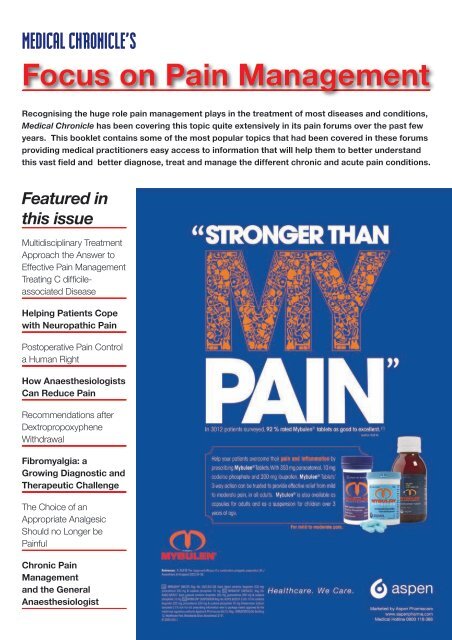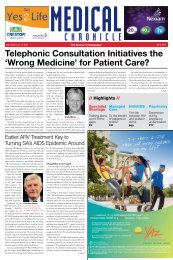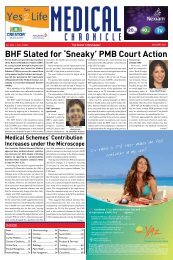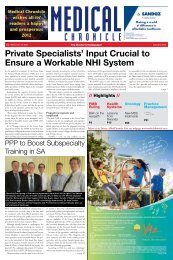Focus on Pain Management - Medical Chronicle
Focus on Pain Management - Medical Chronicle
Focus on Pain Management - Medical Chronicle
Create successful ePaper yourself
Turn your PDF publications into a flip-book with our unique Google optimized e-Paper software.
MEDICAL CHRONICLE’S<br />
<str<strong>on</strong>g>Focus</str<strong>on</strong>g> <strong>on</strong> <strong>Pain</strong> <strong>Management</strong><br />
Recognising the huge role pain management plays in the treatment of most diseases and c<strong>on</strong>diti<strong>on</strong>s,<br />
<strong>Medical</strong> Chr<strong>on</strong>icle has been covering this topic quite extensively in its pain forums over the past few<br />
years. This booklet c<strong>on</strong>tains some of the most popular topics that had been covered in these forums<br />
providing medical practiti<strong>on</strong>ers easy access to informati<strong>on</strong> that will help them to better understand<br />
this vast field and better diagnose, treat and manage the different chr<strong>on</strong>ic and acute pain c<strong>on</strong>diti<strong>on</strong>s.<br />
Featured in<br />
this issue<br />
Multidisciplinary Treatment<br />
Approach the Answer to<br />
Effective <strong>Pain</strong> <strong>Management</strong><br />
Treating C difficileassociated<br />
Disease<br />
Helping Patients Cope<br />
with Neuropathic <strong>Pain</strong><br />
Postoperative <strong>Pain</strong> C<strong>on</strong>trol<br />
a Human Right<br />
How Anaesthesiologists<br />
Can Reduce <strong>Pain</strong><br />
Recommendati<strong>on</strong>s after<br />
Dextropropoxyphene<br />
Withdrawal<br />
Fibromyalgia: a<br />
Growing Diagnostic and<br />
Therapeutic Challenge<br />
The Choice of an<br />
Appropriate Analgesic<br />
Should no L<strong>on</strong>ger be<br />
<strong>Pain</strong>ful<br />
Chr<strong>on</strong>ic <strong>Pain</strong><br />
<strong>Management</strong><br />
and the General<br />
Anaesthesiologist
<strong>Pain</strong> <strong>Management</strong><br />
Multidisciplinary Treatment Approach the<br />
Answer to Effective <strong>Pain</strong> <strong>Management</strong><br />
Prof Helgard Meyer,<br />
Past-President: <strong>Pain</strong> SA<br />
<strong>Pain</strong> has become the most comm<strong>on</strong> reas<strong>on</strong> for<br />
a patient’s decisi<strong>on</strong> to seek medical attenti<strong>on</strong>,<br />
particularly in primary care.<br />
In a study of 25 primary healthcare centres<br />
in Finland, pain was identified as the reas<strong>on</strong><br />
for 40% of the visits, dem<strong>on</strong>strating that pain<br />
is not <strong>on</strong>ly a major primary healthcare problem<br />
but also has an enormous socio-ec<strong>on</strong>omic impact<br />
<strong>on</strong> public health. Twenty per cent of these<br />
patients had experienced chr<strong>on</strong>ic pain for over<br />
six m<strong>on</strong>ths.<br />
In a 1998 World Health Organizati<strong>on</strong> survey<br />
of approximately 26 000 primary-care patients<br />
<strong>on</strong> five c<strong>on</strong>tinents, 22% reported persistent<br />
pain over the past year, associated with marked<br />
Biopsychosocial model of pain<br />
reducti<strong>on</strong>s in several different indicators of<br />
well-being, particularly psychological illness and<br />
interference with activities. No epidemiological<br />
data are available for SA, but it is presumed to<br />
follow internati<strong>on</strong>al prevalence patterns.<br />
Advances in classificati<strong>on</strong> and management<br />
The explosive growth in the knowledge of pain<br />
in recent years has produced major advances in<br />
the classificati<strong>on</strong> and management of pain.<br />
The modern paradigm of pain management<br />
has moved from the c<strong>on</strong>cept of a specific pain<br />
pathway as the source of pain to intricate brain<br />
mechanisms that integrate sensory, emoti<strong>on</strong>al<br />
and cognitive systems during the processing and<br />
experience of pain.<br />
There is a heightened awareness of acute<br />
pain as the 5th vital sign, which may induce<br />
l<strong>on</strong>g-term sensitisati<strong>on</strong> of the nervous system<br />
and chr<strong>on</strong>ic pain in some patients, if not treated<br />
appropriately.<br />
Nociceptive pain occurs when peripheral nociceptors<br />
are stimulated by various noxious stimuli<br />
(e.g. post-surgical pain), and neuro pathic pain<br />
follows injury to the nervous system.<br />
In dysfuncti<strong>on</strong>al pain disorders no peripheral<br />
abnormality is detected and the pain results from<br />
the abnormal sensory processing of incoming<br />
impulses (e.g. irritable bowel syndrome and<br />
fibromyalgia).<br />
Acute pain serves a protective purpose and<br />
warns of danger.<br />
However, chr<strong>on</strong>ic pain has little or no protective<br />
significance and may persist in the<br />
absence of tissue damage after normalisati<strong>on</strong> of<br />
... to page 4<br />
A <strong>Medical</strong> Chr<strong>on</strong>icle supplement August 2011 • 3
<strong>Pain</strong> <strong>Management</strong><br />
Multidisciplinary Treatment<br />
Approach the Answer to<br />
Effective <strong>Pain</strong> <strong>Management</strong><br />
... from page 3<br />
injury or disease. It can therefore be regarded as<br />
a dysfuncti<strong>on</strong>al resp<strong>on</strong>se and has been termed<br />
a disease in its own right by the Internati<strong>on</strong>al<br />
Associati<strong>on</strong> for the Study of <strong>Pain</strong> (IASP) and<br />
mostly requires l<strong>on</strong>g-term management.<br />
Chr<strong>on</strong>ic pain may persist l<strong>on</strong>g after initial<br />
tissue trauma has resolved and may be substantially<br />
influenced by emoti<strong>on</strong>al and psychosocial<br />
factors.<br />
Evidence-based approach<br />
The ‘trial-and-error’ subjective approach to<br />
pain management, which often prevails, has<br />
been replaced by evidence-based medicine with<br />
newer methods of assessing and c<strong>on</strong>trolling pain.<br />
This shift in the paradigm of pain management<br />
worldwide is based <strong>on</strong> more appropriate educati<strong>on</strong><br />
and training, and is also driven by patients’<br />
rights issues.<br />
In a developing healthcare system such as<br />
in SA, primary healthcare providers are in the<br />
most favourable positi<strong>on</strong> to be resp<strong>on</strong>sible for the<br />
initial assessment and management of patients<br />
in pain. Only patients with more complicated<br />
pain disorders would be referred to appropriate<br />
specialists.<br />
The biomedical approach to chr<strong>on</strong>ic pain often<br />
promises a cure by cutting or blocking the pain<br />
pathways. The biopsychosocial model views pain<br />
as a complex sensory/psychosocial interacti<strong>on</strong><br />
and more realistic management goals mostly<br />
include a reducti<strong>on</strong> (not necessarily eliminati<strong>on</strong>)<br />
of pain, the targeting of potential pain-related<br />
disability (including return to work) and the<br />
development of self-management strategies.<br />
Str<strong>on</strong>g efforts should be made to keep patients<br />
with persistent pain integrated in their lives<br />
to prevent subsequent mood changes, such as<br />
depressi<strong>on</strong> and anxiety.<br />
Best outcomes<br />
The best outcomes in chr<strong>on</strong>ic pain manage-<br />
ment are obtained through an interdisciplinary<br />
approach which often includes educati<strong>on</strong>, behavioural<br />
therapy, physiotherapy and exercise,<br />
and pharmacological therapy.<br />
Procedural interventi<strong>on</strong>s are indicated in a<br />
small subset of chr<strong>on</strong>ic pain patients <strong>on</strong>ly after<br />
well-managed, appropriate, c<strong>on</strong>servative approaches<br />
have failed.<br />
Despite all these advances in the understanding<br />
and management of pain, various surveys<br />
repeatedly reveal that unrelieved pain remains<br />
a widespread problem and that pain is often<br />
undertreated.<br />
Part of the problem relates to deficiencies in<br />
pain knowledge am<strong>on</strong>g healthcare professi<strong>on</strong>als,<br />
owing to the fact that educati<strong>on</strong>al programmes,<br />
including those for undergraduates, mostly<br />
include minimal or no pain c<strong>on</strong>tent.<br />
References available <strong>on</strong> request.<br />
Comp<strong>on</strong>ents of chr<strong>on</strong>ic pain<br />
management<br />
• Interdisciplinary<br />
• Educati<strong>on</strong><br />
• Emphasis <strong>on</strong> patient’s active role<br />
• Pharmacological management<br />
- Primary analgesics:<br />
s Paracetamol<br />
s NSAIDS/Coxibs<br />
s Opioids<br />
- Sec<strong>on</strong>dary analgesics:<br />
s Antidepressants<br />
s Antic<strong>on</strong>vulsants<br />
• Physical therapy<br />
• Exercise therapy (Biokineticist)<br />
• Behavioural therapy<br />
• Occupati<strong>on</strong>al therapy<br />
• Interventi<strong>on</strong>s<br />
4 • August 2011 A <strong>Medical</strong> Chr<strong>on</strong>icle supplement
<strong>Pain</strong> <strong>Management</strong><br />
Helping Patients Cope with<br />
Neuropathic <strong>Pain</strong><br />
Prof CL Odendaal<br />
Department of Anaesthesiology, Faculty of<br />
Health Sciences, Free State University<br />
Neuropathic pain is characterised by tingling, sharp<br />
paroxysmal sensati<strong>on</strong>s or burning dysaesthesias and<br />
is traditi<strong>on</strong>ally managed with adjuvant medica-<br />
ti<strong>on</strong>s, including antidepressant and antic<strong>on</strong>vulsant<br />
drugs, rather than the opioid analgesic agents used<br />
for visceral and somatic pains. However, lately,<br />
opioids are being used successfully in the treatment<br />
of neuropathic pain.<br />
Many patients suffer from neuropathic pain as<br />
a result of injury to the peripheral nervous system<br />
(e.g. limb amputati<strong>on</strong>, post-herpetic neuralgia or<br />
diabetic neuropathy) or to the central nervous<br />
system (e.g. spinal cord injury or stroke).<br />
The most distinctive symptom of neuropathic<br />
pain is allodynia, whereby normally n<strong>on</strong>-painful<br />
stimuli, such as light touch, are interpreted as pain.<br />
Traditi<strong>on</strong>ally, inflammatory and neuropathic<br />
pain syndromes have been c<strong>on</strong>sidered distinct<br />
entities. However, recent evidence shows the c<strong>on</strong>trary.<br />
Nerve damage can stimulate macrophage<br />
infiltrati<strong>on</strong> and increase the number of activated T<br />
cells. Under these c<strong>on</strong>diti<strong>on</strong>s, neuro-inflammatory<br />
and immune resp<strong>on</strong>ses c<strong>on</strong>tribute as much to the<br />
development and maintenance of chr<strong>on</strong>ic pain as<br />
the initial damage itself. Recently, studies using<br />
animal models have shown that up-regulati<strong>on</strong> of<br />
chemokines is <strong>on</strong>e of the mechanisms underlying<br />
the development and maintenance of chr<strong>on</strong>ic pain.<br />
Chr<strong>on</strong>ic, n<strong>on</strong>-cancer-related pain (most comm<strong>on</strong>ly<br />
seen in pain clinics) involves several different<br />
pathophysiological problems that usually<br />
render the sufferer unable to enjoy life, but do not<br />
directly threaten life. This type of pain is most often<br />
described in relati<strong>on</strong> to an anatomical site and typically<br />
engenders c<strong>on</strong>siderable anxiety.<br />
Myofascial pain (i.e. pain arising from muscle<br />
and c<strong>on</strong>nective tissue), another extremely comm<strong>on</strong><br />
cause of patients visiting the pain clinic, accounts<br />
for a c<strong>on</strong>siderable amount of chr<strong>on</strong>ic, n<strong>on</strong>-cancerrelated<br />
pain. It requires specific active therapy<br />
(e.g. stretching, trigger point injecti<strong>on</strong>s, intensive<br />
physiotherapy) and corrective acti<strong>on</strong>s for pain relief.<br />
Neuropathic pain<br />
Neuropathic pain, caused by a lesi<strong>on</strong> or dysfunc-<br />
ti<strong>on</strong> of the nervous system is especially problematic<br />
because:<br />
• It is often experienced in parts of the body that<br />
otherwise appear normal.<br />
• It is generally chr<strong>on</strong>ic, severe and resistant to<br />
over-the-counter analgesics.<br />
• It is further aggravated by allodynia (touchevoked<br />
pain).<br />
It may result from various causes that affect the<br />
brain, spinal cord and peripheral nerves, including<br />
cervical or lumbar radiculopathy, diabetic neuropathy,<br />
cancer-related neuropathic pain, post-herpetic<br />
neuralgia, HIV-related neuropathy, spinal cord<br />
injury, trigeminal neuralgia and complex regi<strong>on</strong>al<br />
pain syndrome (CRPS) type II, am<strong>on</strong>g others.<br />
CRPS type I is a classic neuropathic-type pain but<br />
there is no definable nerve lesi<strong>on</strong>.<br />
The epidemiology of neuropathic pain has not<br />
been adequately studied, partly because of the<br />
diversity of the associated c<strong>on</strong>diti<strong>on</strong>s. Current<br />
pooled estimates suggest that neuropathic pain<br />
may affect as much as 3% of the populati<strong>on</strong> in<br />
the US. SA has no data regarding the incidence of<br />
neuropathic pain.<br />
The impact of neuropathic pain is most vividly<br />
appreciated by people who pers<strong>on</strong>ally experience<br />
this devastating c<strong>on</strong>diti<strong>on</strong>. Those affected have<br />
described their pain using the McGill <strong>Pain</strong><br />
Questi<strong>on</strong>naire with descriptors such as ‘punishingcruel’<br />
and ‘tiring-exhausting’. Ample evidence<br />
indicates that neuropathic pain impairs patients’<br />
mood, quality of life, activities of daily living and<br />
performance at work. People with the c<strong>on</strong>diti<strong>on</strong><br />
have been found to generate three-fold higher<br />
healthcare costs compared to matched c<strong>on</strong>trols.<br />
In the US, health care, disability and related costs<br />
associated with chr<strong>on</strong>ic pain have been estimated<br />
at $150bn annually, of which almost $40bn is attributable<br />
to neuropathic pain. No such data are<br />
available in SA.<br />
Pathophysiology and molecular mechanisms<br />
of neuropathic pain<br />
Three different mechanisms play a role in the<br />
pathophysiology of neuropathic pain:<br />
1. Peripheral mechanisms<br />
Regenerati<strong>on</strong> after nerve injury results in the<br />
formati<strong>on</strong> of neuromas and sprouting of new<br />
nerve projecti<strong>on</strong>s am<strong>on</strong>g uninjured neighbouring<br />
neur<strong>on</strong>s. Collateral sprouting then leads to<br />
altered sensory properties that may be realised as<br />
expanded receptive fields. Unc<strong>on</strong>trolled neur<strong>on</strong>al<br />
firing after experimental nerve injury is largely<br />
attributed to increased expressi<strong>on</strong> of sodium channels.<br />
This mechanism is supported by several lines<br />
of evidence, including blockade of neuropathic pain<br />
with sodium-channel-blocking local anaesthetics.<br />
Demyelinati<strong>on</strong> of diseased nerves may be<br />
another cause of increased neur<strong>on</strong>al excitability.<br />
In additi<strong>on</strong> to sodium channels, expressi<strong>on</strong> of<br />
voltage-gated calcium channels is also increased<br />
following nerve injury. Calcium entry through<br />
voltage-gated calcium channels is necessary for<br />
the release of substance P as well as glutamate from<br />
injured peripheral nerves. Within the dorsal root<br />
gangli<strong>on</strong>, increased expressi<strong>on</strong> of the α-2-delta subunit<br />
of voltage-gated calcium channels correlates<br />
with <strong>on</strong>set and durati<strong>on</strong> of allodynia. Clinical<br />
support of the role of this protein in neuropathic<br />
pain arises from the analgesic efficacy of α-2-delta<br />
voltage-gated calcium-channel antag<strong>on</strong>ists, gabapentin<br />
and pregabalin.<br />
... to page 6<br />
A <strong>Medical</strong> Chr<strong>on</strong>icle supplement August 2011 • 5
<strong>Pain</strong> <strong>Management</strong><br />
Helping Patients Cope<br />
with Neuropathic <strong>Pain</strong><br />
... from page 5<br />
2. Central mechanisms<br />
Sustained painful stimuli result in spinal sensi-<br />
tisati<strong>on</strong>, which is defined as heightened sensitivity<br />
of spinal neur<strong>on</strong>s, reduced activati<strong>on</strong> thresholds<br />
and enhanced resp<strong>on</strong>siveness to synaptic inputs<br />
(i.e. more likely to transmit pain to the brain).<br />
This can manifest in expansi<strong>on</strong> of the affected<br />
area, increased resp<strong>on</strong>se to painful inputs and<br />
transmissi<strong>on</strong> of pain following n<strong>on</strong>-painful<br />
stimuli. Central sensitisati<strong>on</strong> is largely mediated<br />
by the N-methyl-D-aspartate (NMDA) receptor.<br />
Although experimental NMDA-receptor blockade<br />
clearly suppresses central sensitisati<strong>on</strong>, analgesic efficacy<br />
of NMDA antag<strong>on</strong>ists has been disappointing,<br />
probably because of the narrow therapeutic<br />
window of available agents.<br />
Activati<strong>on</strong> of descending pathways (the periaqueductal<br />
grey-rostral ventromedial medulla) has<br />
been shown to reduce pain transmissi<strong>on</strong> in animals<br />
and humans, and is thought to c<strong>on</strong>tribute to the<br />
analgesic effect of opioids and antidepressants.<br />
3. Sympathetically maintained pain<br />
The importance of the sympathetic nervous<br />
system in neuropathic pain has been dem<strong>on</strong>strated<br />
by analgesia following sympathectomy in animals<br />
and humans, and by pain exacerbati<strong>on</strong> through<br />
activati<strong>on</strong> of the sympathetic nervous system.<br />
Sympathetically maintained pain may be explained<br />
by sprouting of sympathetic neur<strong>on</strong>s into<br />
dorsal root ganglia of injured sensory neur<strong>on</strong>s and<br />
post-injury sprouting of sympathetic fibres into<br />
the dermis.<br />
Clinical presentati<strong>on</strong> and evaluati<strong>on</strong> of<br />
patients<br />
The disrupti<strong>on</strong> of nerve c<strong>on</strong>ducti<strong>on</strong> in neuropathic<br />
c<strong>on</strong>diti<strong>on</strong>s causes nerve dysfuncti<strong>on</strong>,<br />
which can result in numbness, weakness and loss<br />
of deep tend<strong>on</strong> reflexes in the affected nerve area.<br />
Neuropathic c<strong>on</strong>diti<strong>on</strong>s also cause aberrant symptoms<br />
of sp<strong>on</strong>taneous and stimulus-evoked pain.<br />
Sp<strong>on</strong>taneous pain (c<strong>on</strong>tinuous or intermittent) is<br />
comm<strong>on</strong>, as is hyperalgesia (increased pain evoked<br />
by a painful stimulus).<br />
Allodynia can be caused by the lightest stimulati<strong>on</strong>,<br />
such as skin c<strong>on</strong>tact with clothing or a light<br />
breeze. These sensory abnormalities may extend<br />
bey<strong>on</strong>d nerve distributi<strong>on</strong>s, which may lead to the<br />
inappropriate diagnosis of a functi<strong>on</strong>al or psychosomatic<br />
disorder. The diagnosis of neuropathic<br />
pain is based primarily <strong>on</strong> history and findings <strong>on</strong><br />
physical examinati<strong>on</strong>.<br />
Assessment of the patient with suspected<br />
neuropathic pain should focus <strong>on</strong> ruling out<br />
treatable c<strong>on</strong>diti<strong>on</strong>s (e.g. spinal cord compressi<strong>on</strong>,<br />
neoplasm), c<strong>on</strong>firming the diagnosis of neuropathic<br />
pain and identifying clinical features (e.g.<br />
insomnia, aut<strong>on</strong>omic neuropathy) that might help<br />
an individual’s treatment.<br />
Current management<br />
N<strong>on</strong>pharmacological<br />
Although many patients with neuropathic pain<br />
pursue complementary and alternative treatments,<br />
rigorous evidence supporting efficacy of n<strong>on</strong>-drug<br />
therapy is limited. Some reports suggest benefits of<br />
c<strong>on</strong>servative interventi<strong>on</strong>s such as exercise, transcutaneous<br />
electrical nerve stimulati<strong>on</strong>, percutaneous<br />
electrical nerve stimulati<strong>on</strong>, graded motor imagery<br />
and cognitive behavioural therapy or supportive<br />
psychotherapy.<br />
Pharmacological<br />
One approach to estimate treatment efficacy<br />
using randomised c<strong>on</strong>trolled trial (RCT) data is<br />
based <strong>on</strong> the number needed-to-treat (NNT) to<br />
obtain at least 50% pain relief in <strong>on</strong>e patient. The<br />
NNT c<strong>on</strong>cept is hampered by methodological<br />
variability across different RCTs, the short-term<br />
nature of most RCTs and the lack of c<strong>on</strong>siderati<strong>on</strong><br />
for other important outcomes (disability, quality of<br />
life). Also, most RCTs have involved patients with<br />
diabetic peripheral neuropathy and post-herpetic<br />
neuralgia, and the results do not necessarily apply<br />
to other neuropathic pain c<strong>on</strong>diti<strong>on</strong>s.<br />
Tricyclic antidepressants<br />
These drugs have repeatedly been shown to<br />
reduce neuropathic pain. Analgesic acti<strong>on</strong>s may<br />
be attributable to noradrenaline and serot<strong>on</strong>in<br />
reuptake blockade (presumably enhancing descending<br />
inhibiti<strong>on</strong>), NMDA-receptor antag<strong>on</strong>ism<br />
and sodium-channel blockade. The NNT is about<br />
three for both balanced noradrenaline and serot<strong>on</strong>in<br />
reuptake inhibitors (e.g. amitriptyline) and<br />
predominantly noradrenaline reuptake inhibitors<br />
(e.g. nortriptyline).<br />
Selective serot<strong>on</strong>in reuptake inhibitors (NNT =<br />
6.7) and mixed serot<strong>on</strong>in- noradrenaline re uptake<br />
inhibitors (SNRIs) (venlafaxine and duloxetine,<br />
NNT = 4.1-5.5) do not appear to be as effective<br />
as tricyclic antidepressants. Duloxetine is the<br />
<strong>on</strong>ly SNRI registered in SA for the treatment of<br />
neuropathic pain.<br />
Antic<strong>on</strong>vulsants<br />
Based <strong>on</strong> methodologically flawed trials, carba-<br />
mazepine and phenytoin have NNTs of 2.1-2.3 for<br />
diabetic peripheral neuropathy. Both have significant<br />
adverse effects, making them generally poor<br />
candidates for first-line therapy. Carbamazepine,<br />
however, is still c<strong>on</strong>sidered first-line therapy for<br />
trigeminal neuralgia, a unique neuropathic pain<br />
c<strong>on</strong>diti<strong>on</strong> (NNT = 1.7).<br />
Gabapentin, an α-2-delta subunit voltage-gated<br />
calcium channel antag<strong>on</strong>ist, has repeatedly dem<strong>on</strong>strated<br />
analgesic efficacy and improvements<br />
in mood and sleep in several RCTs (NNT = 3.8).<br />
Pregabalin is a gabapentin analogue with a similar<br />
mechanism, higher calcium-channel affinity and<br />
better bioavailability. Pregabalin was superior to<br />
placebo in several RCTs in diabetic peripheral<br />
neuropathy and postherpetic neuralgia (NNT =<br />
4.2). Pregabalin has also been registered in SA for<br />
the treatment of neuropathic pain.<br />
RCTs of other antic<strong>on</strong>vulsants, including<br />
valproate, lamotrigine and topiramate, have had<br />
equivocal results.<br />
Opioid analgesics<br />
The role of opioid analgesics in neuropathic pain<br />
has been c<strong>on</strong>troversial. However, a recent metaanalysis<br />
provides c<strong>on</strong>vincing evidence of benefit.<br />
Although 14 short-term RCTs (
Helping Patients Cope<br />
with Neuropathic <strong>Pain</strong><br />
... from page 6<br />
patients (most of whom had neuropathic pain) who<br />
had received chr<strong>on</strong>ic opioid therapy for <strong>on</strong>e year or<br />
more suggest that many patients may c<strong>on</strong>tinue to<br />
enjoy persistent pain relief with opioids.<br />
Tramadol is a weak opioid and a mixed SNRI.<br />
Three RCTs of tramadol for neuropathic pain<br />
yielded an overall NNT of 3.9.<br />
Methad<strong>on</strong>e is a synthetic opioid, potentially<br />
useful for c<strong>on</strong>trolling neuropathic pain because of<br />
its NMDA-antag<strong>on</strong>ist properties. However, its l<strong>on</strong>g<br />
half-life (24-36 hours) necessitates extremely careful<br />
dose titrati<strong>on</strong>. Two small RCTs of methad<strong>on</strong>e<br />
dem<strong>on</strong>strated benefit in managing neuropathic<br />
pain, and open-label experience suggests promise<br />
in a wide variety of neuropathic pain c<strong>on</strong>diti<strong>on</strong>s.<br />
NMDA antag<strong>on</strong>ists<br />
Because of the critical role of NMDA activity<br />
in central sensitisati<strong>on</strong>, NMDA antag<strong>on</strong>ists hold<br />
promise in the management of neuropathic pain.<br />
Unfortunately, available agents have limited efficacy<br />
and produce intolerable side effects. Ketamine, an<br />
intravenous anaesthetic with NMDA-antag<strong>on</strong>ist activity,<br />
has been found to be effective in small RCTs.<br />
Approach to neuropathic pain management in<br />
primary care<br />
No single drug works for all neuropathic pain<br />
states, and given the diversity of pain mechanisms,<br />
patient resp<strong>on</strong>ses and diseases, treatment must<br />
be individualised. Other than analgesia, factors<br />
to c<strong>on</strong>sider when individualising therapy include<br />
tolerability, other benefits (e.g. improved sleep,<br />
mood and quality of life), low likelihood of serious<br />
adverse events and cost-effectiveness to the patient<br />
and the healthcare system. The evidence-based approach<br />
presented here may require revisi<strong>on</strong>, as newer<br />
treatments and clinical evidence become available.<br />
<strong>Pain</strong> management requires <strong>on</strong>going evaluati<strong>on</strong>,<br />
patient educati<strong>on</strong> and reassurance. Diagnostic evaluati<strong>on</strong><br />
of treatable underlying c<strong>on</strong>diti<strong>on</strong>s (e.g. spinal<br />
cord compressi<strong>on</strong>, herniated disc, neoplasm) should<br />
c<strong>on</strong>tinue c<strong>on</strong>currently with pain management.<br />
Patients require educati<strong>on</strong> regarding the natural<br />
history of their c<strong>on</strong>diti<strong>on</strong> and realistic treatment<br />
expectati<strong>on</strong>s (e.g. current treatments are not curative<br />
and analgesia is rarely complete). Even a 30%<br />
pain reducti<strong>on</strong> is clinically important to patients.<br />
<strong>Pain</strong> severity, patient complexity (e.g. coexisting<br />
depressi<strong>on</strong> or substance abuse), failure of attempted<br />
treatments and availability of healthcare resources<br />
should be c<strong>on</strong>sidered when planning referrals to<br />
pain clinics and related specialists. Patient compliance<br />
and adequacy of analgesic drug titrati<strong>on</strong>s (e.g.<br />
dose and durati<strong>on</strong> of treatment) should be c<strong>on</strong>tinually<br />
evaluated and documented.<br />
Neuropathic pain is best managed with a multidisciplinary<br />
approach. Nevertheless, several different<br />
treatments can be initiated in the primary care<br />
setting. Treatments with the lowest risk of adverse<br />
effects should be tried first. Evidence supporting<br />
c<strong>on</strong>servative n<strong>on</strong>-pharmacological treatments (e.g.<br />
physiotherapy, exercise, transcutaneous electrical<br />
nerve stimulati<strong>on</strong>) is limited. However, given their<br />
presumed safety, n<strong>on</strong>-pharmacological treatments<br />
should be c<strong>on</strong>sidered whenever appropriate.<br />
Simple analgesics (e.g. acetaminophen, NSAIDs)<br />
are usually ineffective in pure neuropathic pain but<br />
may help with a coexisting nociceptive c<strong>on</strong>diti<strong>on</strong><br />
(e.g. sciatica with musculoskeletal low-back pain,<br />
myofascial pain syndrome). Early referrals to a<br />
pain clinic for nerve blocks may be warranted in<br />
some cases to facilitate physiotherapy and pain<br />
rehabilitati<strong>on</strong>.<br />
For other neuropathic pain diagnoses, oral m<strong>on</strong>otherapy<br />
with antic<strong>on</strong>vulsants, a tricyclic antidepressant<br />
or a mixed SNRI is recommended. Tricyclic<br />
Table 1: Aetiology of neuropathic pain<br />
Classificati<strong>on</strong> Aetiology<br />
Hereditary Porphyria<br />
Metabolic Diabetes mellitus<br />
Nutriti<strong>on</strong>al deficiency<br />
Hypothyroid<br />
Amyloid<br />
Uraemic<br />
Immune mediated Multiple myeloma<br />
Infectious Post-herpetic<br />
HIV<br />
Toxic (including Is<strong>on</strong>iazide<br />
drugs)<br />
Nitrofuratoin<br />
Vincristine<br />
Cisplatin<br />
Arsenic<br />
Thallium<br />
Compressi<strong>on</strong> Tumour<br />
Radiati<strong>on</strong> fibrosis<br />
Ischaemic Peripheral vascular<br />
disease<br />
Traumatic/ Peripheral nerve injuries<br />
post-surgical Stump pain and<br />
phantom limb pain<br />
<strong>Pain</strong> <strong>Management</strong><br />
antidepressants appear to be more efficacious and<br />
much less expensive but have a higher likelihood of<br />
adverse effects and are relatively c<strong>on</strong>traindicated for<br />
use in patients with serious cardiovascular disease<br />
(a screening electrocardiogram is recommended before<br />
prescribing tricyclic antidepressants), postural<br />
hypotensi<strong>on</strong>, urinary retenti<strong>on</strong> and angle-closure<br />
glaucoma.<br />
Am<strong>on</strong>g available tricyclic antidepressants, nortriptyline<br />
and desipramine are more highly recommended<br />
because of fewer side effects. Newer mixed<br />
SNRIs (e.g. venlafaxine, duloxetine) may not be as<br />
efficacious as tricyclic antidepressants but appear<br />
to be better tolerated. Of these antic<strong>on</strong>vulsants,<br />
gabapentin and pregabalin appear to be the best<br />
tolerated, with very few drug interacti<strong>on</strong>s.<br />
C<strong>on</strong>clusi<strong>on</strong><br />
Neuropathic pain is widely recognised as <strong>on</strong>e<br />
of the most difficult-to-treat pain syndromes. A<br />
comm<strong>on</strong> cause of poor outcome is the failure to<br />
properly assess and effectively treat real and significant<br />
psychological cofactors and emoti<strong>on</strong>al comorbidities<br />
that make coping with chr<strong>on</strong>ic pain so<br />
difficult - such as poor sleep, depressi<strong>on</strong> and anxiety.<br />
These cofactors and comorbid c<strong>on</strong>diti<strong>on</strong>s represent a<br />
dynamic triad of negatively reinforcing pathologies<br />
that must be adequately assessed in each patient<br />
to optimise treatment outcome. Assessment of an<br />
individual patient can be carried out promptly and<br />
efficiently if the clinician relies mostly <strong>on</strong> patient<br />
self-evaluati<strong>on</strong> using relatively simple screening<br />
questi<strong>on</strong>naires, such as the Brief <strong>Pain</strong> Inventory,<br />
Beck Depressi<strong>on</strong> Inventory and sleep diaries. These<br />
assessment tools can identify those patients with<br />
psychological distress and psychiatric comorbidities,<br />
who will require further evaluati<strong>on</strong> to determine a<br />
diagnosis and begin treatment, choosing from a<br />
wide range of effective pharmacological therapies<br />
and psychotherapies.<br />
Effective treatment of comorbidities will enhance<br />
outcomes of pain treatment. Single-agent therapy is<br />
possible in many situati<strong>on</strong>s, especially when drugs<br />
are selected to address both the pain and the most<br />
significant comorbidities. Though it is relatively<br />
rare for a patient to obtain complete pain relief,<br />
improvements in functi<strong>on</strong>ality and quality of life<br />
are clearly obtainable goals in the treatment of<br />
neuropathic pain patients and, indeed, represent the<br />
most practical measures of effectiveness at this time.<br />
References available <strong>on</strong> request.<br />
A <strong>Medical</strong> Chr<strong>on</strong>icle supplement August 2011 • 7
<strong>Pain</strong> <strong>Management</strong><br />
Postoperative <strong>Pain</strong> C<strong>on</strong>trol<br />
a Human Right<br />
Dr Milt<strong>on</strong> Raff,<br />
President, <strong>Pain</strong>SA<br />
The Internati<strong>on</strong>al Associati<strong>on</strong> for the Study of<br />
<strong>Pain</strong> (IASP) has declared the period from October<br />
2010 to September 2011 as the Year of Acute <strong>Pain</strong><br />
<strong>Management</strong>. <strong>Management</strong> of acute pain is not<br />
a luxury - it is a human right. Postoperative pain<br />
management falls within this category and these<br />
patients should be carefully managed.<br />
Three broad categories of pain exist. The first<br />
is nociceptive pain, which is pain re sulting<br />
from a noxious insult to the body. This is<br />
often followed by the sec<strong>on</strong>d type of pain, inflammatory<br />
pain, resulting from the release of inflammatory<br />
mediators from the various tissue types.<br />
The last category is neuropathic pain, which<br />
results from damage or disease to the nervous system.<br />
The picture can become complicated in that<br />
pain may be of a mixed variety such as that found<br />
in cancer and lower back pain, where there is more<br />
than <strong>on</strong>e type of pain comp<strong>on</strong>ent involved.<br />
The reas<strong>on</strong> for this classificati<strong>on</strong> is that, in<br />
broad terms, both nociceptive and inflammatory<br />
pain will resp<strong>on</strong>d to opioids, paracetamol, n<strong>on</strong>steroidal<br />
anti-inflammatory drugs (NSAIDs) and<br />
cycloxygenase-2 inhibitors (Coxibs).<br />
Neuropathic pain is unlike the other two types,<br />
in that it tends to resp<strong>on</strong>d to other classes of drugs<br />
such as delta-2 calcium channel blockers, antiepileptics<br />
and various classes of antidepressants. For<br />
the purposes of our discussi<strong>on</strong>, we must state that<br />
postoperative pain is nociceptive pain.<br />
There are many means and methods to achieve<br />
good postoperative pain c<strong>on</strong>trol. A basic understanding<br />
of the mechanisms involved in pain<br />
percepti<strong>on</strong> and the management of these mechanisms<br />
is needed.<br />
The steps used to c<strong>on</strong>trol pain are based <strong>on</strong> your<br />
clinical experience and the clinical state of the<br />
patient and their specific comorbidities. It is very<br />
clear that the multimodal model of pain management<br />
has significant benefits for the patient in<br />
terms of pain management and that all or some<br />
of the steps described below should be utilised for<br />
optimal management of postoperative and other<br />
forms of acute pain.<br />
The multimodal model uses the synergistic<br />
properties of the various agents to enhance the<br />
analgesia while administering lower doses of<br />
each agent.<br />
At the same time, the use of lower doses of each<br />
agent diminishes the frequency of the side effects<br />
of the various agents employed.<br />
The following are the physiological steps of<br />
pain percepti<strong>on</strong>.<br />
Step 1<br />
A surgical insult will result in the release of an<br />
‘inflammatory soup’ that c<strong>on</strong>tains prostaglandins.<br />
Managing this release is possible using NSAIDs<br />
or Coxibs. Evidence shows that either class of<br />
drug may be used, as both have equal analgesic<br />
properties in the acute situati<strong>on</strong>.<br />
Step 2<br />
Once a nerve impulse has been generated, it<br />
will be transferred from the peri phery to the spinal<br />
cord by means of peripheral nerves. The mecha-<br />
nism of transfer involves sodium i<strong>on</strong>s.<br />
Blocking of the sodium channels will, there-<br />
fore, inhibit transfer of the painful impulse.<br />
A local anaesthetic would do this.<br />
Several local anaesthetic soluti<strong>on</strong>s are available<br />
and the point that the block must be administered<br />
will be based <strong>on</strong> the individual patient.<br />
Table 1 outlines appropriate c<strong>on</strong>texts where a<br />
local anaesthetic may be indicated.<br />
Table 1: Type and site of local anaesthetic<br />
Local anaesthetic Site of administrati<strong>on</strong><br />
Lignocaine Skin infiltrati<strong>on</strong><br />
Bupivacaine Wound infiltrati<strong>on</strong><br />
Ropivacaine Joint infiltrati<strong>on</strong><br />
Levobupivacaine Ring block<br />
Prilocaine Peripheral nerve<br />
block<br />
Amethocaine Plexus nerve block<br />
Epidural block<br />
Spinal block<br />
Step 3<br />
The impulse reaches the dorsal horn of the<br />
spinal cord. In order to transfer the pain sensati<strong>on</strong>,<br />
a process involving calcium i<strong>on</strong>s is involved.<br />
Gabapentinoids prevent influx of the calcium into<br />
the cells. This class of drugs blocks the alpha-2<br />
delta sub-unit of the calcium channel.<br />
Patients with<br />
postoperative pain<br />
should be carefully<br />
managed<br />
The most comm<strong>on</strong>ly employed agents are<br />
gabapentin and pregabalin. These agents may<br />
be used as part of a premedicati<strong>on</strong> and can be<br />
c<strong>on</strong>tinued into the post operative phase. There is<br />
good evidence dem<strong>on</strong>strating the opioid-sparing<br />
effect of these agents.<br />
8 • August 2011 A <strong>Medical</strong> Chr<strong>on</strong>icle supplement<br />
Step 4<br />
Further impulse c<strong>on</strong>ducti<strong>on</strong> involves activating<br />
the N-methyl-D-aspartate (NMDA) receptors in<br />
the spinal cord. It is possible to block this receptor<br />
by using ketamine. This can be used in the form<br />
of a single bolus or a c<strong>on</strong>tinuous infusi<strong>on</strong>.<br />
Step 5<br />
Transfer of the pain message from the dorsal<br />
horn of the spinal cord to the cortex and limbic<br />
system. The cycloxygenase system plays a significant<br />
role in this regard and it can be inhibited<br />
by the use of NSAIDs and Coxibs as well as<br />
paracetamol.<br />
It is clear that the use of intravenous paracetamol<br />
significantly reduces opioid use and greatly increases<br />
postoperative pain relief.<br />
Step 6<br />
The mainstay of pain relief remains opioids.<br />
... to page 10
<strong>Pain</strong> <strong>Management</strong><br />
Postoperative <strong>Pain</strong><br />
C<strong>on</strong>trol a Human Right<br />
... from page 8<br />
However, their use is associated with a myriad of<br />
side effects. The aim of multimodal analgesia is<br />
to reduce the use of opioids in order to decrease<br />
their side effects. Opioids do play a significant<br />
role in postoperative analgesia and when other<br />
agents have proven ineffective, opioids must be<br />
administered.<br />
The intravenous route for administrati<strong>on</strong> of<br />
the opioids is a predictable <strong>on</strong>e and acts within<br />
a short timeframe. It does not make sense to use<br />
the intramuscular, rectal or oral route in an acute<br />
situati<strong>on</strong>, as absorpti<strong>on</strong> via these routes is slow and<br />
unpredictable, being influenced by many factors,<br />
including blood flow to the various body tissues.<br />
Step 7<br />
The limbic system has a mechanism of inhibit-<br />
ing the incoming painful impulse at the dorsal<br />
horn via serot<strong>on</strong>in and noradrenaline. These two<br />
substances affect an inhibitory resp<strong>on</strong>se and by<br />
so doing, lessen the pain experience.<br />
We can employ this mechanism as part of a<br />
Table 2: Site of acti<strong>on</strong>, mechanism and agents<br />
Step Site of acti<strong>on</strong> Mechanism Agents<br />
1 Peri pheral Prosta glandins NSAIDs<br />
Coxibs<br />
2 Nerves Sodium i<strong>on</strong> Local anaesthetics<br />
3 Dorsal horn Calcium i<strong>on</strong> Pregabalin<br />
Gabapentin<br />
4 Dorsal horn NMDA Ketamine<br />
5 Spinal cord Prosta glandins Paracetamol<br />
NSAIDs<br />
Coxibs<br />
6 Cerebral cortex Opioid receptors Opioids<br />
7 Limbic system Serot<strong>on</strong>in<br />
Nor adrenaline<br />
Tramadol<br />
multimodal regimen, by using tramadol. This acts<br />
at the spinal cord level by inhibiting the reuptake<br />
of serot<strong>on</strong>in and noradrenaline, thus mimicking<br />
the natural inhibitory system.<br />
There are obviously many ways to administer<br />
these drugs. These include patient-c<strong>on</strong>trolled analgesic<br />
pumps, intrathecal drug delivery systems,<br />
single shot and c<strong>on</strong>tinuous infusi<strong>on</strong> techniques.<br />
Once again, the choice of agents, the routes of<br />
administrati<strong>on</strong> and the appropriate indicati<strong>on</strong>s<br />
and c<strong>on</strong>traindicati<strong>on</strong> for the drugs remains the<br />
choice of the doctor involved.<br />
Table 2 summarises the ‘tools’ available to<br />
improve the management of postoperative pain.<br />
This is d<strong>on</strong>e by understanding the mechanism of<br />
the physiological c<strong>on</strong>ducti<strong>on</strong> of the pain impulse<br />
through the various sites of communicati<strong>on</strong> in<br />
the nervous system.<br />
It clearly is not appropriate to use every tool<br />
<strong>on</strong> every patient, but as many agents as possible<br />
should be used to ensure that, in applying multimodal<br />
analgesia and the synergism that this<br />
provides, patients are as pain free as possible, with<br />
minimal side effects.<br />
10 • August 2011 A <strong>Medical</strong> Chr<strong>on</strong>icle supplement
<strong>Pain</strong> <strong>Management</strong><br />
How Anaesthesiologists<br />
Can Reduce <strong>Pain</strong><br />
Dr Eric Hodgs<strong>on</strong><br />
Sec<strong>on</strong>dary analgesics, such as antidepressants,<br />
antic<strong>on</strong>vulsants and antiarrhythmics as well<br />
as neuraxial techniques all have a role to play<br />
in terms of chr<strong>on</strong>ic pain management. Specific<br />
clinical c<strong>on</strong>diti<strong>on</strong>s such as back pain and failedback-surgery<br />
syndrome will also be examined.<br />
Sec<strong>on</strong>dary analgesics are drugs that are used<br />
for indicati<strong>on</strong>s other than pain relief but have<br />
analgesia as <strong>on</strong>e of their sec<strong>on</strong>dary effects.<br />
Antidepressants<br />
Tricyclic antidepressants (TCAs) are still<br />
the mainstay of chr<strong>on</strong>ic pain treatment. These<br />
drugs have a number of beneficial effects in<br />
additi<strong>on</strong> to their analgesic properties mediated<br />
by noradrenaline (NA) and 5HT3 reuptake<br />
inhibiti<strong>on</strong>. Amitriptyline and dothiepin have<br />
significant sedative effects that are very useful<br />
where chr<strong>on</strong>ic pain is associated with insomnia.<br />
Nortryptiline is a less sedating drug that is useful<br />
if sedati<strong>on</strong> becomes problematic. Muscle spasm<br />
is a prominent comp<strong>on</strong>ent of many chr<strong>on</strong>ic pain<br />
c<strong>on</strong>diti<strong>on</strong>s which, c<strong>on</strong>trary to the beliefs of many<br />
clinicians, is better treated with a TCA than a<br />
benzodiazepine. Not <strong>on</strong>ly are the anticholinergic<br />
effects of the TCAs much more potent in terms<br />
of muscle relaxati<strong>on</strong> than the effects of benzodiazepines<br />
<strong>on</strong> the GABA receptors, but TCAs<br />
are not addictive while benzodiazepines cause<br />
rapid dependence.<br />
Atypical antidepressants include duloxetine<br />
and venlafaxine. Despite 30 years of experience<br />
with amitriptyline, there are <strong>on</strong>ly 17 papers <strong>on</strong><br />
the use of amitriptyline in the treatment of pain<br />
compared with 244 for duloxetine. N<strong>on</strong>etheless,<br />
the approach of most pain clinicians would be to<br />
start with a TCA for acute treatment and <strong>on</strong>ly<br />
switch to the more expensive alternatives in cases<br />
of treatment failure or side effects.<br />
Antic<strong>on</strong>vulsants<br />
Carbamazepine was the first antic<strong>on</strong>vulsant<br />
to show benefit for the treatment of neuropathic<br />
pain and is still the drug of choice for trigeminal<br />
neuralgia. The risk of liver and b<strong>on</strong>e marrow<br />
damage with carbamazepine and the unpredictable<br />
pharmacokinetics of the drug require<br />
regular levels.<br />
Cl<strong>on</strong>azepam has been used, particularly for<br />
sciatica and phantom pain, but the dissociati<strong>on</strong><br />
experienced by patients <strong>on</strong> both a TCA and<br />
cl<strong>on</strong>azepam may be felt to be more unpleasant<br />
than the pain itself.<br />
Thus, unlike the antidepressants, the newer<br />
antic<strong>on</strong>vulsants, gabapentin and pregabalin,<br />
have superior efficacy and reduced side effects<br />
compared with the older drugs. Pregabalin has<br />
predictable, linear pharmacokinetics but superior<br />
efficacy compared with gabapentin (clinical use<br />
has yet to be fully elucidated).<br />
Antiarrhythmics<br />
Some forms of neuropathic pain may prove<br />
refractory to TCAs, antic<strong>on</strong>vulsants and opioids.<br />
A small number of these patients may resp<strong>on</strong>d<br />
to lignocaine, and its oral equivalent mexelitine.<br />
Due to the profound gastrointestinal (GI) side<br />
effects of mexelitine, a diagnostic lignocaine infusi<strong>on</strong><br />
(5mg/kg over <strong>on</strong>e hour) should be used to<br />
define efficacy. A good resp<strong>on</strong>se to the diagnostic<br />
infusi<strong>on</strong> means patients are more likely to tolerate<br />
the GI side effects of mexelitine to achieve<br />
good quality pain relief.<br />
Neuraxial techniques<br />
General anaesthetists may be requested to<br />
place epidural catheters for a trial of neur-<br />
axial drugs (local anaesthetic ±opioid ±alpha 2<br />
ag<strong>on</strong>ist /s-ketamine) in pain patients where other<br />
approaches have failed. The catheter should be<br />
placed under aseptic c<strong>on</strong>diti<strong>on</strong>s in an operating<br />
theatre if possible. A wire-reinforced catheter<br />
should be used to avoid problems of kinking.<br />
Screening to c<strong>on</strong>firm appropriate placement<br />
(using a small volume of myelogram c<strong>on</strong>trast) is<br />
justified. Limited tunnelling of the catheter to<br />
6-8cm lateral to the spine, using the Tuohy needle<br />
as a c<strong>on</strong>duit, improves patient comfort and<br />
reduces the risk of dislodgement. The catheter<br />
should be covered with a clear, semi-permeable<br />
dressing, which should include the c<strong>on</strong>necti<strong>on</strong><br />
between the catheter and the filter, to reduce the<br />
risk of disc<strong>on</strong>necti<strong>on</strong>. Drug delivery should be<br />
undertaken by a specialist pain team.<br />
Specific clinical c<strong>on</strong>diti<strong>on</strong>s<br />
Back pain<br />
N<strong>on</strong>-surgical management of back pain is successful<br />
in more than 90% of cases. The ‘red flags’,<br />
indicating impending permanent neurological<br />
dysfuncti<strong>on</strong> in associati<strong>on</strong> with back pain may<br />
be remembered by the mnem<strong>on</strong>ic TUNA FISH<br />
(J Fam Pract 2009;58(12):E1):<br />
Trauma - including neuraxial interventi<strong>on</strong> in<br />
the last two weeks<br />
Unexplained weight loss<br />
Neurological signs - Motor deficits and/or loss<br />
of sphincter c<strong>on</strong>trol<br />
Age >70 - with no previous episodes<br />
Fever / raised C-reactive protein (CRP)<br />
Intravenous drug use<br />
Steroid use: >20mg/day for >30 days within the<br />
last six m<strong>on</strong>ths for a l<strong>on</strong>g time<br />
History of cancer<br />
Failed-back-surgery syndrome<br />
Surgery for pain relief is unsuccessful in up to<br />
20% of cases. <strong>Pain</strong> may persist for a number of<br />
reas<strong>on</strong>s, the most comm<strong>on</strong> of which is pain coming<br />
from an anatomical structure other than the<br />
intervertebral disc. Reoperati<strong>on</strong>s are much less<br />
successful compared with primary procedures.<br />
Complicati<strong>on</strong>s or failure of the first procedure<br />
account for 60% of reoperati<strong>on</strong>s, while 40% are<br />
required for new or uncorrected abnormalities.<br />
Patients presenting for spinal reoperati<strong>on</strong> often<br />
have prol<strong>on</strong>ged or severe preoperative pain with<br />
opioid tolerance or resistance. There is a steadily<br />
decreasing chance for resoluti<strong>on</strong> of symptoms as<br />
more procedures are d<strong>on</strong>e.<br />
A <strong>Medical</strong> Chr<strong>on</strong>icle supplement August 2011 • 11
<strong>Pain</strong> <strong>Management</strong><br />
Recommendati<strong>on</strong>s after<br />
Dextropropoxyphene Withdrawal<br />
Dr Milt<strong>on</strong> Raff<br />
President <strong>Pain</strong>SA and Chairpers<strong>on</strong> of the WFSA<br />
Acute <strong>Pain</strong> Committee<br />
The South African analgesic market is valued at ap-<br />
proximately a half a billi<strong>on</strong> rand. Almost <strong>on</strong>e third<br />
of this market is attributable to products c<strong>on</strong>taining<br />
dextropropoxyphene (DPP).This often maligned<br />
compound has recently been withdrawn as a result<br />
of the findings of the Medicines C<strong>on</strong>trol Council.<br />
Many questi<strong>on</strong>s have subsequently arisen but two<br />
of the most pertinent enquiries are Why? and What<br />
can be used in its place?<br />
The ‘why’ is quite c<strong>on</strong>tentious but is a result of the<br />
fact that many reports of DPP side effects have been<br />
published. The adverse events described are addicti<strong>on</strong>,<br />
arrhythmias and alcohol-related deaths. Given that<br />
DPP was so frequently used in SA, the validity of the<br />
studies should be questi<strong>on</strong>ed. These studies have been<br />
examined and found to be scientifically sound and<br />
valid. If this is the case, then the removal of dextropropoxyphene<br />
from the market is the correct decisi<strong>on</strong>.<br />
We must then ask why we have not seen similar<br />
problems. An explanati<strong>on</strong> may be that we have not<br />
looked for these adverse events or have attributed any<br />
perceived adverse events to a different cause. The fact<br />
of the matter is that DPP has been withdrawn from<br />
the SA market with immediate effect.<br />
The issue of what can be used in its place must<br />
be discussed, as the ‘spend’ <strong>on</strong> the DPP-c<strong>on</strong>taining<br />
products was huge. Prescribing doctors will be forced<br />
Severe pain<br />
Moderate to<br />
severe pain<br />
Mild to<br />
moderate<br />
pain<br />
Step 3:<br />
Str<strong>on</strong>g opioids (e.g.<br />
morphine), with or<br />
without n<strong>on</strong>-opioids<br />
Step 2:<br />
Mild opioids (e.g. codeine),<br />
with or without n<strong>on</strong>-opioids<br />
Step 1:<br />
N<strong>on</strong>-opioids - aspirin, n<strong>on</strong>steroidal<br />
anti-inflammatory<br />
drugs (NSAIDs) or paracetamol<br />
Figure 1: WHO analgesic ladder<br />
to find an alternative and the choice should be based<br />
<strong>on</strong> science.<br />
To simplify matters, we must look at the World<br />
Heath Organizati<strong>on</strong>’s (WHO) pain ladder (see<br />
Figure 1). We must also look at available analgesic<br />
compounds and their efficacy. Surely, this ladder is<br />
not complete in that it makes no reference to neuropathic<br />
pain but it does serve as a guide to the rati<strong>on</strong>al<br />
approach to pain therapy. Analgesic efficacy needs to<br />
be standardised so that the efficacy of the different<br />
compounds can be compared. This has been made<br />
possible by the term ‘number needed to treat’ (NNT).<br />
The NNT is an epidemiological measure used<br />
in assessing the effectiveness of a health care interventi<strong>on</strong>,<br />
typically a treatment with medicati<strong>on</strong>.<br />
The NNT is the number of patients who need to<br />
be treated in order to prevent <strong>on</strong>e additi<strong>on</strong>al bad<br />
outcome (i.e. the number of patients that need to be<br />
treated for <strong>on</strong>e to benefit compared with a c<strong>on</strong>trol in<br />
a clinical trial). It is defined as the inverse of the absolute<br />
risk reducti<strong>on</strong>. It was described in 1988 (http://<br />
en.wikipedia.org/wiki/ number_needed_to_treat -<br />
cite_note-0). The ideal NNT is <strong>on</strong>e, where every<strong>on</strong>e<br />
improves with treatment and no <strong>on</strong>e improves with<br />
the c<strong>on</strong>trol. The higher the NNT number, the less<br />
effective the treatment.<br />
We must c<strong>on</strong>sider whether the compound analgesics<br />
c<strong>on</strong>tain <strong>on</strong>ly proven analgesic molecules<br />
or do they also c<strong>on</strong>tain other substances that have<br />
absolutely no beneficial analgesic effects and may be<br />
harmful to patients.<br />
As menti<strong>on</strong>ed, the WHO provides a guide as to<br />
the type of analgesics that should be used for the<br />
different levels of pain (see Figure 1). It is unambiguous<br />
in stating that for mild to moderate pain, health<br />
professi<strong>on</strong>als should <strong>on</strong>ly use proven compounds such<br />
as paracetamol or aspirin and, should these al<strong>on</strong>e<br />
provide insufficient pain relief, then a n<strong>on</strong>-steroidal<br />
anti-inflammatory agent (NSAID) should be added.<br />
The group of agents known as the COX-2 inhibitors<br />
may be substituted in place of the NSAIDs.<br />
If the pain is more severe, then the regimen should<br />
be augmented by mild opioids, such as codeine<br />
and tramadol. The final step where pain is severe<br />
would require the additi<strong>on</strong> of str<strong>on</strong>g opioids, such<br />
Table 1: Oxford pain table<br />
Analgesic and dose (mg) NNT<br />
Etoricoxib 180/240 1.5<br />
Etoricoxib 120 1.6<br />
Diclofenac 100 1.8<br />
Celecoxib 400 2.1<br />
Paracetamol 1000 + Codeine 60 2.2<br />
Aspirin 1200 2.4<br />
Ibuprofen 400 2.5<br />
Diclofenac 25 2.6<br />
Ketorolac 10 2.6<br />
Naproxen 400/440 2.7<br />
Piroxicam 20 2.7<br />
Naproxen 500/550 2.7<br />
Diclofenac 50 2.7<br />
Ibuprofen 200 2.7<br />
Tramadol 150 2.9<br />
Morphine 10 (intramuscular) 2.9<br />
Naproxen 200/220 3.4<br />
Ketorolac 30 (intramuscular) 3.4<br />
Paracetamol 500 3.5<br />
Celecoxib 200 3.5<br />
Ibuprofen 100 3.7<br />
Paracetamol 1000 3.8<br />
Paracetamol 600/650 + Codeine 60 4.2<br />
Aspirin 600/650 4.4<br />
Paracetamol 600/650 4.6<br />
Ibuprofen 50 4.7<br />
Tramadol 100 4.8<br />
Tramadol 75 5.3<br />
Aspirin 650 + Codeine 60 5.3<br />
Paracetamol 300 + Codeine 30 5.7<br />
Tramadol 50 8.3<br />
Codeine 60 16.7<br />
as morphine and buprenorphine. Extreme pain may<br />
also be managed with transdermal fentanyl patches.<br />
Practiti<strong>on</strong>ers can be guided by the NNT as to<br />
which agent they should use, but their knowledge<br />
of their patient and the specific indicati<strong>on</strong>s and<br />
c<strong>on</strong>traindicati<strong>on</strong>s will be the final determinant as<br />
to their choice of agent. The Oxford pain table can<br />
supply the necessary data to enable the choice of<br />
agent (see Table 1).<br />
The NNT of the more comm<strong>on</strong>ly utilised agents<br />
can be illustrated by Figures 2 and 3, when they are<br />
prescribed as single agents.<br />
One of the problems that we all face is compliance<br />
by the patients. Should doctors prescribe two, three or<br />
four different agents and will the patient take the correct<br />
agent at the correct time? The answer to this questi<strong>on</strong><br />
is an unreserved ‘No’! This phenomen<strong>on</strong> has led<br />
... to page 14<br />
12 • August 2011 A <strong>Medical</strong> Chr<strong>on</strong>icle supplement
<strong>Pain</strong> <strong>Management</strong><br />
Recommendati<strong>on</strong>s after<br />
Dextropropoxyphene<br />
Withdrawal<br />
... from page 12<br />
to the manufacture of combinati<strong>on</strong> analgesic tablets<br />
and capsules. SA has in excess of 90 such combinati<strong>on</strong><br />
products, c<strong>on</strong>taining a variety of substances. I believe<br />
that it befalls us as prescribing practiti<strong>on</strong>ers to prescribe<br />
products that c<strong>on</strong>tain <strong>on</strong>ly proven analgesic agents.<br />
Diclofenac 100mg 1.9<br />
Ibuprofen 400mg 2.4<br />
Morphine 10mg (IM) 3.8<br />
Acetaminophen 1000mg 3.8<br />
Aspirin 650mg 4.4<br />
Tramadol 100mg 4.8<br />
Codeine 60mg 16.6<br />
0 1 2 3 4 5 6 7 8<br />
Numbers needed to treat<br />
Figure 2: NNT of comm<strong>on</strong> agents<br />
In this way, we can use synergism to reduce the<br />
dosages of the individual agents in the combinati<strong>on</strong>,<br />
thereby reducing any potential side effects while<br />
increasing the desired analgesic properties of the<br />
combinati<strong>on</strong>. Many such ‘pure’ combinati<strong>on</strong>s are<br />
available <strong>on</strong> the local market (see Table 2).<br />
Table 2: Efficacy of combinati<strong>on</strong> analgesics<br />
Analgesic (mg) NNT<br />
Paracetamol 1000 + codeine 60 2.2<br />
Paracetamol 600/650 + codeine 60 4.2<br />
Paracetamol 300 + codeine 30 5.7<br />
Paracetamol 650 + tramadol 75 2.6<br />
These NNTs can be further reduced by the additi<strong>on</strong><br />
of NSAIDs to the combinati<strong>on</strong> preparati<strong>on</strong>.<br />
I have referred to n<strong>on</strong>-analgesic agents used<br />
in combinati<strong>on</strong> analgesic products in SA. I have<br />
included a table of the agents, their drug class and<br />
major side effects (see Table 3).<br />
It should be fairly obvious that these agents have<br />
no role to play in analgesia. If the prescriber wishes<br />
to sedate his/her patient, then there are far more appropriate<br />
agents to use and the adverse effects of the<br />
agents described above offer no benefit to our patients<br />
and especially not in terms of analgesia. What then are<br />
the opti<strong>on</strong>s available to medical practiti<strong>on</strong>ers who wish<br />
to manage pain appropriately, follow the guidelines<br />
of the WHO and ensure compliance by the patient?<br />
Mild to moderate pain<br />
• Paracetamol<br />
• NSAIDs<br />
• Coxibs<br />
• Aspirin<br />
Many combinati<strong>on</strong> preparati<strong>on</strong>s of these sub-<br />
stances are available - the most comm<strong>on</strong> being those<br />
of paracetamol and ibuprofen.<br />
Moderate to severe pain<br />
• Tramadol<br />
• Codeine<br />
Given that DPP is no l<strong>on</strong>ger available, the next<br />
most comm<strong>on</strong>ly prescribed combinati<strong>on</strong>s c<strong>on</strong>tain<br />
codeine, paracetamol and ibuprofen (or tramadol)<br />
and paracetamol. These combinati<strong>on</strong>s make perfect<br />
pharmacological sense in that they c<strong>on</strong>sist of <strong>on</strong>ly<br />
Table 3: Overview of agents<br />
Agent Class of drug Use Major side effects<br />
Meprobamate Carbamate Anxiolytic<br />
C<strong>on</strong>vulsi<strong>on</strong>s<br />
Muscle relaxant Dependence<br />
Caffeine Xanthine alkaloid CNS stimulant Tachycardia<br />
Anxiety and headaches<br />
Sleep disorders<br />
Diphenhydramine Antihistamine Allergic reacti<strong>on</strong>s Anticholinergic effects<br />
Sedati<strong>on</strong><br />
Doxylamine Antihistamine Cold and allergy relief Antichol<strong>on</strong>ergic effects<br />
Sedati<strong>on</strong><br />
Phenobarbit<strong>on</strong>e Barbiturate Antic<strong>on</strong>vulsant Sedati<strong>on</strong><br />
CNS effects<br />
Figure 3 Etoricoxib 120<br />
Valdecoxib 40<br />
Celecoxib 400<br />
Paracetamol/codeine 1000/60<br />
Rofecoxib 50<br />
Ibuprofen 400<br />
Lumiracoxib 400<br />
Naproxen 500/550<br />
Diclofenac 50<br />
Morphine 10 IM<br />
Paracetamol 1000<br />
Aspirin 600/650<br />
Tramadol 100<br />
1 2 3 4 5 6 7<br />
95% CI of NNT for at least 50% pain relief compared with placebo<br />
proven analgesic substances combined in lower doses<br />
than as single agents al<strong>on</strong>e. This ensures synergism<br />
resulting in better analgesia with reduced side effects<br />
compared to when the individual agents are used<br />
al<strong>on</strong>e. Of course, we should expect adverse effects as<br />
with the use of any drug.<br />
Severe pain<br />
• Morphine<br />
• Buprenorphine<br />
• Tramadol (SR preparati<strong>on</strong>s)<br />
• Fentanyl (transdermal patches)<br />
Morphine remains the ‘gold standard’ for severe<br />
pain management.<br />
It may be noted that pethidine has been omitted<br />
from this list. This agent is certainly an extremely<br />
good sedative but not a good analgesic and is of great<br />
c<strong>on</strong>cern regarding its side effect profile as a result of its<br />
metabolite, norpethidine. It is also the leading agent<br />
when it comes to drug-seeking behaviour.<br />
There is very good evidence to suggest that this<br />
agent should be removed from the internati<strong>on</strong>al<br />
pharmacopoeia and it is already unavailable in many<br />
parts of the world.<br />
It must be stressed that all agents must be used<br />
appropriately and that correct prescribing habits must<br />
be encouraged. Because most of the combinati<strong>on</strong><br />
agents are composed of low-dose agents, they need to<br />
be taken at regular intervals rather than occasi<strong>on</strong>ally.<br />
This implies regular medicati<strong>on</strong> rather than the ‘pro<br />
renata’ (PRN). This will ensure that therapeutic levels<br />
of the analgesics are c<strong>on</strong>stant and if used as such, will<br />
prevent the ‘sawtooth pattern’ of intermittent pain<br />
relief and pain.<br />
If health porfessi<strong>on</strong>als adhere to sound pharmacological<br />
principles and correct prescribing habits, then<br />
there is no reas<strong>on</strong> for patients to suffer, following the<br />
withdrawal of DPP.<br />
14 • August 2011 A <strong>Medical</strong> Chr<strong>on</strong>icle supplement
<strong>Pain</strong> <strong>Management</strong><br />
Fibromyalgia: a Growing Diagnostic<br />
and Therapeutic Challenge<br />
Dr Eric Hodgs<strong>on</strong><br />
Fibromyalgia (FM) is a chr<strong>on</strong>ic c<strong>on</strong>diti<strong>on</strong> characterised<br />
by widespread pain and tenderness<br />
<strong>on</strong> examinati<strong>on</strong>, al<strong>on</strong>g with symptoms of n<strong>on</strong>restorative<br />
sleep, fatigue and cognitive difficulties.<br />
Fibromyalgia is characterised by:<br />
1. Widespread pain<br />
• Above and below the waist<br />
• Right and left sides of the body<br />
• Axial skelet<strong>on</strong>, especially neck and lumbar spine<br />
2. <strong>Pain</strong> involves at least 11 out of 18 tender points.<br />
In additi<strong>on</strong> to the primary diagnosis of fibromyalgia,<br />
the presence of significant comor bidities<br />
(see Table 1) should be identified, as therapy for the<br />
fibromyalgia will be ineffective if these comorbidities<br />
are not addressed also.<br />
Pharmacotherapy<br />
Fibromyalgia is often inappropriately managed<br />
with n<strong>on</strong>-steroidal anti-inflammatory<br />
drugs (NSAIDs), particularly intramuscular<br />
diclofenac.<br />
As a n<strong>on</strong>-inflammatory pain c<strong>on</strong>diti<strong>on</strong>, fibromyalgia<br />
is unresp<strong>on</strong>sive to NSAID therapy and<br />
patients are c<strong>on</strong>sequently exposed to the risks<br />
of NSAID therapy without any prospect of<br />
pain relief.<br />
Effective pain relief in fibromyalgia may be<br />
achieved with the following:<br />
Tricyclic antidepressants: Amitryptiline, at a<br />
starting dose of 10mg every night, escalated<br />
every two weeks to a maximum dose of 75mg<br />
every night, is the cornerst<strong>on</strong>e of therapy of many<br />
chr<strong>on</strong>ic pain states, including fibromyalgia.<br />
Table 1. Screening questi<strong>on</strong>s for fibromyalgia and associated c<strong>on</strong>diti<strong>on</strong>s<br />
Disorder Screening questi<strong>on</strong>s<br />
Fibromyalgia Have you had whole-body pain for a l<strong>on</strong>g time?<br />
Are various parts of your body painful to touch?<br />
Do you have trouble sleeping?<br />
Do you feel tired more days than not, without an identifiable reas<strong>on</strong>?<br />
Anxiety Over the past two weeks, have you felt nervous, anxious, or ‘<strong>on</strong> edge’?<br />
Over the past two weeks, have you been unable to stop or c<strong>on</strong>trol your worrying?<br />
Chr<strong>on</strong>ic fatigue Have you had more than six m<strong>on</strong>ths of fatigue that is not relieved by rest and is<br />
syndrome severe enough to limit your daily activities?<br />
Have you had any of the following symptoms: fever, sore throat, enlarged or painful<br />
nodes, muscle weakness or pain, headaches, joint aches, trouble c<strong>on</strong>centrating, or<br />
sleep disturbance? Did any of these symptoms occur over several hours to days?<br />
Depressi<strong>on</strong> Over the past two weeks, have you felt ‘down’, depressed, or hopeless?<br />
Over the past two weeks, have you had little interest or pleasure in doing things?<br />
Irritable bowel For three m<strong>on</strong>ths or more in the past year:<br />
syndrome Have you had abdominal pain or discomfort that is not relieved with a bowel<br />
movement? If so, has the pain or discomfort been associated with a change in<br />
stool frequency or appearance?<br />
Do you have other symptoms such as heartburn, difficulty swallowing, nausea,<br />
feeling full so<strong>on</strong> after starting to eat, or bloating?<br />
Restless legs Do you have uncomfortable or unpleasant leg sensati<strong>on</strong>s when sitting or lying down?<br />
syndrome Do you have an urge to move when sitting or lying down?<br />
Are your symptoms worse when you are lying down than when moving around?<br />
Are your symptoms relieved by moving around or walking?<br />
Are your symptoms worse at night?<br />
Sleep apnoea Assess patient for elevated body mass index and hypertensi<strong>on</strong>.<br />
Do you snore?<br />
Does your snoring bother other people?<br />
How often have others noticed pauses in your breathing while sleeping?<br />
Are you tired after sleeping?<br />
Are you tired during the day?<br />
Have you ever fallen asleep while driving?<br />
Temporo- Do you have pain in your temples, face, temporomandibular joint, or jaws at least<br />
mandibular joint <strong>on</strong>ce a week?<br />
dysfuncti<strong>on</strong> Do you have pain at least <strong>on</strong>ce a week when you open your mouth wide or chew?<br />
Beneficial effects include:<br />
• Relief of insomnia by central sedative effects.<br />
Insomnia is a prominent and distressing<br />
symptom of fibromyalgia.<br />
• Relief of muscle spasm by acetylcholine<br />
receptor blockade at spinal cord level. This<br />
anti-spasmodic effect exceeds that of the<br />
benzo diazepines without the addictive potential<br />
of these drugs.<br />
• Sec<strong>on</strong>dary analgesic effects by increasing<br />
levels of noradrenalin and serot<strong>on</strong>in at spinal<br />
cord level through re-uptake inhibiti<strong>on</strong> of<br />
these transmitters. This helps to address the<br />
reducti<strong>on</strong> in descending inhibitory c<strong>on</strong>trol<br />
seen in patients with fibromyalgia.<br />
Serot<strong>on</strong>in noradrenalin reuptake inhibitors<br />
(SNRIs): These include drugs such as duloxetine,<br />
which have been shown to be effective in neuropathic<br />
pain states such as diabetic and postherpetic<br />
neuralgias. Effects in fibromyalgia are<br />
unclear at present, so duloxetine can currently<br />
<strong>on</strong>ly be recommended for patients who are unable<br />
to tolerate the tricyclic antidepressants.<br />
Gabapentinoids: These include gabapentin and<br />
pregabalin, which are both active at the alpha-<br />
2-delta subunit of the neur<strong>on</strong>al voltage-gated<br />
calcium channel. These agents have been shown<br />
to reduce insomnia and fatigue while improving<br />
quality of life.<br />
Opioid analgesics: These have a limited role in<br />
the management of fibromyalgia. Tramadol is<br />
a useful drug, less through its effects of opioid<br />
receptors than <strong>on</strong> its noradrenalin and serot<strong>on</strong>in<br />
reuptake blockade. Buprenorphine has also been<br />
shown to improve symptoms in fibro myalgia with<br />
limited risk of addicti<strong>on</strong>. By c<strong>on</strong>trast, the pure mu<br />
ag<strong>on</strong>ists - such as morphine and fentanyl - are less<br />
useful in the management of fibromyalgia. Mu<br />
ag<strong>on</strong>ists should never be used as first-line therapy<br />
in fibromyalgia, but should be reserved for patients<br />
who have failed to resp<strong>on</strong>d to appropriate trials of<br />
both pharmacological and n<strong>on</strong>- pharmacological<br />
therapy. Opioid therapy for fibromyalgia should<br />
<strong>on</strong>ly be undertaken under the supervisi<strong>on</strong> of a<br />
multidisciplinary pain clinic.<br />
References available <strong>on</strong> request.<br />
A <strong>Medical</strong> Chr<strong>on</strong>icle supplement August 2011 • 15
<strong>Pain</strong> <strong>Management</strong><br />
The Choice of an Appropriate Analgesic<br />
Should no L<strong>on</strong>ger be <strong>Pain</strong>ful<br />
Dr Luc Evenepoel<br />
<strong>Pain</strong> relief is a human right. Trauma patients,<br />
and especially the severely injured, pose an extra<br />
challenge to the treating doctor, since there is a<br />
risk for significant, deleterious side effects from<br />
inappropriate analgesic ad ministrati<strong>on</strong>.<br />
The pain treatment of the trauma victim has<br />
to be individualised: excellent pain relief is, of<br />
course, the goal, but ‘primum n<strong>on</strong> nocere’ (first do<br />
no harm) should never be forgotten.<br />
Assessment of pain<br />
Always ask how much pain the patient has. He/<br />
she can judge this much better than the treating<br />
doctor. Ask awake and oriented patients to rate<br />
their pain from zero to 10, 0/10 signifying no<br />
pain and 10/10 the worst pain imaginable. Most<br />
patients, even children, can easily do this. Also use<br />
this rating to evaluate the effect of the analgesics<br />
administered. Most patients are relatively comfortable<br />
and satisfied when they come down to a<br />
score of 4/10 or less. For small children, a chart<br />
with smiley faces can be used.<br />
Keep in mind that the pain threshold is fairly<br />
similar between individuals, but that pain tolerance<br />
varies: the pain of an identical injury can<br />
be rated 8/10 by <strong>on</strong>e patient, but <strong>on</strong>ly 4/10 by<br />
another. Intoxicated and c<strong>on</strong>fused patients, and<br />
those with a depressed level of c<strong>on</strong>sciousness,<br />
cannot reliably communicate their pain. Do not<br />
withhold analgesia, but be extra cautious, since<br />
opioids may further depress c<strong>on</strong>sciousness, with<br />
the added risk of respiratory depressi<strong>on</strong>.<br />
Analgesics<br />
The main groups are opioids, n<strong>on</strong>-steroidal<br />
anti-inflammatory drugs (NSAIDs), paracetamol<br />
and local anaesthetics. To keep this text c<strong>on</strong>cise,<br />
details have been omitted, but can easily be found<br />
in any pharmacology manual.<br />
For obese patients, the doses should be calculated<br />
according to lean body weight (LBW), which<br />
is ideal body weight (IBW) + 20-30% (ideal body<br />
weight = 22 x (height in metres) 2 e.g. a patient<br />
who weighs 140kg and is 1.76m tall has an IBW<br />
of 22 x (1.76 x 1.76) = 68 kg. LBW is 20 or 30%<br />
more, about 85kg.<br />
Opioids<br />
Not <strong>on</strong>ly pain tolerance varies, but also the<br />
analgesic effect of opioids: it can differ 10-fold<br />
between individuals. These two factors make it<br />
difficult to predict a uniformly effective opioid<br />
dose. Opioids, like all other systemic painkillers,<br />
are analgesics, not anaesthetic agents; they will<br />
dull the pain of a fracture, but cannot take away<br />
the excruciating impulses from a manipulati<strong>on</strong><br />
or surgical procedure. Similarly, they will not<br />
interfere with making a diagnosis. This is, sadly,<br />
still <strong>on</strong>e of the main reas<strong>on</strong>s their use is postp<strong>on</strong>ed<br />
or withheld - such an approach is inappropriate<br />
and cruel.<br />
Excellent pain relief<br />
is, of course, the<br />
goal, but ‘primum<br />
n<strong>on</strong> nocere’ should<br />
never be forgotten<br />
Morphine<br />
Morphine is still the reference opioid - very<br />
effective, widely available and cheap.<br />
The <strong>on</strong>set of analgesic effect is after 3-5 min-<br />
utes, peak analgesic effect after 10-20 minutes,<br />
durati<strong>on</strong> of acti<strong>on</strong> 3-4 hours (six hours in the<br />
elderly). If respiratory depressi<strong>on</strong> occurs, it will<br />
happen approximately seven minutes after morphine<br />
administrati<strong>on</strong>.<br />
Morphine’s effects and side effects described<br />
here are also relevant to the other opioids. It is<br />
preferably given intravenously (IV), in principle<br />
never intramuscularly. Intramuscularly (IM)<br />
injected morphine is not reliably taken up into<br />
the blood stream from poorly perfused muscle,<br />
delaying the analgesic effect and side effects for<br />
many hours (not <strong>on</strong>ly will your patient suffer<br />
pain unnecessarily, but respiratory depressi<strong>on</strong><br />
may occur insidiously, when no <strong>on</strong>e is watching<br />
anymore). The traditi<strong>on</strong>al adult total dose of 0.1-<br />
0.3mg/kg is a rough guideline, and depends <strong>on</strong> the<br />
severity of injury, pain tolerance, and the patient’s<br />
individual opioid sensitivity.<br />
Give morphine in increments of 0.01-0.02 mg/<br />
kg IV every 5-10 minutes. This allows titrati<strong>on</strong> of<br />
the opioid against its effect. The respiratory rate<br />
should stay above 14 breaths/min. Be aware that<br />
respiratory depressi<strong>on</strong> can occur before significant<br />
sedati<strong>on</strong>. For a 60kg adult, give boluses of 0.5-1.5<br />
mg IV every 5-10 minutes.<br />
To make titrati<strong>on</strong> easy, prepare a diluti<strong>on</strong> of<br />
1mg/ml: 10mg morphine (1ml) in 9ml sterile<br />
water (or 0.9% saline or 5% dextrose) makes<br />
10mg/10ml, or 1mg/ml. D<strong>on</strong>’t forget that some<br />
patients might require less than 10mg, others<br />
more or much more. Titrate to effect, aiming for<br />
a pain score of 4/10 or less, but stop when the<br />
patient becomes too sedated or suffers respiratory<br />
depressi<strong>on</strong>. With intravenous administrati<strong>on</strong>, the<br />
<strong>on</strong>set of effect and side effects are predictable:<br />
blood pressure drops within 2-5 minutes, maximum<br />
respiratory depressi<strong>on</strong> occurs within seven<br />
minutes and peak analgesic effect occurs within<br />
10-20 minutes.<br />
Start the opioid titrati<strong>on</strong> during or immediately<br />
after the initial resuscitati<strong>on</strong> and ensure that the<br />
patient is comfortable before any painful examinati<strong>on</strong>,<br />
manipulati<strong>on</strong>, or transport is attempted. Be<br />
aware that morphine can drop the blood pressure<br />
in the hypovolaemic patient, sometimes severely.<br />
If this occurs, resuscitate further, and change<br />
over to other analgesics if needed (e.g. sufentanil,<br />
regi<strong>on</strong>al analgesia).<br />
The analgesic effect of morphine lasts about 3-4<br />
hours. Prescribe regular follow-up doses every four<br />
hours, rather than <strong>on</strong> demand <strong>on</strong>ly.<br />
Ne<strong>on</strong>ates and small children are especially<br />
sensitive to the respiratory depressant effect<br />
... to page 18<br />
16 • August 2011 A <strong>Medical</strong> Chr<strong>on</strong>icle supplement
<strong>Pain</strong> <strong>Management</strong><br />
The Choice of an<br />
Appropriate Analgesic<br />
Should no L<strong>on</strong>ger be <strong>Pain</strong>ful<br />
... from page 16<br />
of opioids. Recommended total doses are therefore<br />
smaller than for adults, i.e.:<br />
• Younger than three m<strong>on</strong>ths: 0.025mg/kg<br />
• Three to 12 m<strong>on</strong>ths: 0.05mg/kg<br />
• Older than 12 m<strong>on</strong>ths: 0.1mg/kg.<br />
Note that injured children are generally anxious,<br />
which c<strong>on</strong>tributes negatively to their pain<br />
percepti<strong>on</strong>. A small amount of an anxiolytic, such<br />
as midazolam 0.1mg/kg orally or IV in increments<br />
of 0.01-0.03mg/kg, in combinati<strong>on</strong> with the<br />
opioid, can be useful.<br />
For children, dilute 10mg morphine (= 1ml)<br />
to 100ml: this makes a c<strong>on</strong>centrati<strong>on</strong> of 0.1mg/<br />
ml. Administer 0.1-0.3ml/kg IV of this mixture<br />
every 5-10 minutes. Ne<strong>on</strong>ates are very sensitive:<br />
use small increments, and wait for the effect,<br />
d<strong>on</strong>’t be hasty.<br />
Side effects of morphine (and other opioids)<br />
Hypotensi<strong>on</strong><br />
Because of histamine release, even small<br />
amounts of morphine may cause a drop in blood<br />
pressure in hypovolaemic patients. Halve the dose,<br />
and wait l<strong>on</strong>g enough in between the increments to<br />
ensure the blood pressure remains stable. Note that<br />
elderly patients are especially pr<strong>on</strong>e to hypotensi<strong>on</strong>.<br />
Respiratory depressi<strong>on</strong><br />
The risk is vastly enhanced in patients who have<br />
ingested alcohol, benzodiazepines, barbiturates, or<br />
other central nervous system depressants. Titrate<br />
to effect and watch for side effects. The fear for<br />
respiratory depressi<strong>on</strong> is what often makes medical<br />
pers<strong>on</strong>nel underdose their patient (too little,<br />
too late), causing unnecessary suffering. <strong>Pain</strong> is<br />
an excellent antag<strong>on</strong>ist for respiratory depressi<strong>on</strong>.<br />
Do not administer morphine to head-injured<br />
patients, where respiratory depressi<strong>on</strong> leads to<br />
hypercapnia, cerebral vasodilati<strong>on</strong>, and increased<br />
intracranial pressure. If the patient is ventilated,<br />
this of course becomes irrelevant, because the<br />
ventilator ensures normocapnia.<br />
Pethidine<br />
Pethidine has some anticholinergic properties:<br />
its mild positive chr<strong>on</strong>otropic effect is especially<br />
attractive in small children because they depend<br />
mainly <strong>on</strong> heart rate to maintain their cardiac output.<br />
Do not give to elderly patients because it can<br />
lead to c<strong>on</strong>fusi<strong>on</strong>. Avoid with renal impairment<br />
(accumulati<strong>on</strong> and toxicity, risk for c<strong>on</strong>vulsi<strong>on</strong>s).<br />
The durati<strong>on</strong> of effect is 2-3 hours, not six hours<br />
as it is comm<strong>on</strong>ly prescribed. The recommended<br />
dose is 1-1.5mg/kg.<br />
As for morphine, intravenous titrati<strong>on</strong> of small<br />
increments is str<strong>on</strong>gly preferred over intramuscular<br />
administrati<strong>on</strong>. Increments of 10-15mg are<br />
suitable for the average adult. In children, increments<br />
of 0.1-0.2mg/kg are suitable, with the same<br />
precauti<strong>on</strong>s as menti<strong>on</strong>ed for morphine.<br />
The fear for<br />
respiratory<br />
depressi<strong>on</strong> is<br />
what often makes<br />
medical pers<strong>on</strong>nel<br />
underdose their<br />
patient (too little,<br />
too late), causing<br />
unnecessary<br />
suffering<br />
Pethidine has a dysphoric effect in some patients<br />
(morphine is mildly euphoric). Ask your<br />
patient if he/she ever had an opioid in the past,<br />
and about its effect and side effects. Morphine<br />
remains the opioid of choice.<br />
Tilidine<br />
Tilidine is effective against moderate to mod-<br />
erately severe pain. It is well absorbed when given<br />
sublingually or intranasally, but should not be<br />
given intravenously. The durati<strong>on</strong> of acti<strong>on</strong> is<br />
4-6 hours.<br />
Adult dose: 50-100mg, but it should be individualised.<br />
It is often necessary to start with<br />
100mg, repeated after two hours with another<br />
100mg; thereafter 50-100mg every 4-6 hours.<br />
Paediatric drops (2.5mg per drop): generally<br />
1mg/kg. In children 1-9 years, give <strong>on</strong>e drop per<br />
year of age plus two drops; or the weight in kg/2.5<br />
= the number of drops. In children 10 years and<br />
older, the weight in kg/2.5 = the number of drops.<br />
Do not give to children less than <strong>on</strong>e year old.<br />
Tramadol<br />
Tramadol is effective against moderate to mode-<br />
rately severe pain, but is unsuited to treatment of<br />
severe pain. Its main advantage is the lack of<br />
respiratory depressi<strong>on</strong>. Tramadol is the preferred<br />
opioid for sp<strong>on</strong>taneously breathing head-injured<br />
patients, as it has very little respiratory depressant<br />
effect. Titrate to effect, approximately 0.15mg/kg<br />
every 3-5 minutes, until the patient is comfortable.<br />
Depending <strong>on</strong> certain characteristics of<br />
metabolism of the patient, tramadol might not<br />
work well, or work str<strong>on</strong>ger than expected (with,<br />
indeed, some respiratory depressi<strong>on</strong>). Again,<br />
titrate to effect.<br />
Do not use in combinati<strong>on</strong> with pethidine or<br />
HT3-antag<strong>on</strong>ist anti-emetics like granisetr<strong>on</strong>,<br />
<strong>on</strong>dansetr<strong>on</strong>, dolasetr<strong>on</strong> - there is the risk of<br />
serot<strong>on</strong>inergic syndrome. This syndrome is characterised<br />
by mental symptoms (disorientati<strong>on</strong>,<br />
agitati<strong>on</strong>, c<strong>on</strong>fusi<strong>on</strong>, hallucinati<strong>on</strong>s), aut<strong>on</strong>omic<br />
symptoms (hypertensi<strong>on</strong>, tachycardia, sweating,<br />
diaphoresis, hyperthermia, mydriasis) and<br />
musculoskeletal symptoms (tremors, shivering,<br />
hypert<strong>on</strong>ia, stuttering). These symptoms can also<br />
be seen with intravenous administrati<strong>on</strong> that is too<br />
quick. The use of tramadol is not recommended<br />
for children less than 14 years old.<br />
Sufentanyl<br />
Sufentanyl is quicker in <strong>on</strong>set of effect and side<br />
effects (1-5 minutes) than morphine, and there-<br />
fore more efficient to titrate IV. It is much more<br />
cardiovascularly stable than morphine, and has a<br />
short durati<strong>on</strong> of acti<strong>on</strong> (1-2 hours), so d<strong>on</strong>’t forget<br />
to reassess the patient’s pain, and re-administer<br />
analgesics if needed.<br />
One ampoule of 2ml c<strong>on</strong>tains 0.01mg (10mcg)<br />
sufentanyl. Titrate IV with increments of 0.02-<br />
0.04mcg/kg every 2-5 minutes, i.e. 1.25-2.5mcg<br />
(0.25-0.5ml) per bolus for a 60kg adult.<br />
Codeine<br />
In spite of popular belief, codeine is a poor an-<br />
algesic. Codeine is popular am<strong>on</strong>g neuro surge<strong>on</strong>s<br />
to treat pain in head-injured patients, because it<br />
has little respiratory depressant effects. Tramadol<br />
remains an attractive alternative.<br />
18 • August 2011 A <strong>Medical</strong> Chr<strong>on</strong>icle supplement
<strong>Pain</strong> <strong>Management</strong><br />
Chr<strong>on</strong>ic <strong>Pain</strong> <strong>Management</strong> and<br />
the General Anaesthesiologist<br />
Dr Eric Hodgs<strong>on</strong><br />
N<strong>on</strong>steroidal anti-inflammatory drugs (NSAIDs)<br />
have a unique role in pain management. Studies<br />
from the Brain Research Institute at the University<br />
of the Witwatersrand have shown that NSAIDs do<br />
not provide analgesia but are potent antihyperalgesics.<br />
To understand the difference, it is necessary<br />
to understand the c<strong>on</strong>cept of the pain threshold.<br />
Inflammati<strong>on</strong> shifts the stimulus resp<strong>on</strong>se<br />
curve for pain to the left so that stimuli that would<br />
not induce pain in the c<strong>on</strong>trol situati<strong>on</strong> are now<br />
painful - hyperalgesia. In additi<strong>on</strong>, stimuli such<br />
as light touch, that are not painful are perceived<br />
as painful - allodynia. NSAIDs can return the<br />
stimulus resp<strong>on</strong>se curve back towards normal but<br />
cannot shift the curve to the right of baseline, and<br />
are thus not analgesic.<br />
NSAIDs affect nitric oxide synthase (NOS)<br />
in the spinal cord via guanylate cyclase to reduce<br />
central sensitisati<strong>on</strong>. The effect of NSAIDs <strong>on</strong> NS<br />
is also being implicated in the cardiovascular side<br />
effects of these drugs.<br />
Biochemically the NSAIDs may be classified<br />
as follows:<br />
1. Full inhibiti<strong>on</strong> of both COX-1 and COX-2<br />
with poor selectivity - aspirin, diclofenac,<br />
ibuprofen<br />
2. Full inhibiti<strong>on</strong> of COX-1 and COX-2 with<br />
preference toward COX-2 - celecoxib (initial),<br />
meloxicam<br />
3. Str<strong>on</strong>g inhibiti<strong>on</strong> of COX-2 with <strong>on</strong>ly weak<br />
activity against COX-1 - celecoxib (delayed),<br />
etoricoxib, parecoxib<br />
4. Weak inhibitors of COX-1 and COX-2 - sulindac,<br />
paracetamol<br />
Clinically there are three subdivisi<strong>on</strong>s of the<br />
NSAIDs:<br />
1. N<strong>on</strong>-selective NSAIDs (nsNSAIDs): Block<br />
both COX-1 and 2 to variable extents<br />
a. Aspirin-like: Predominant COX-1 block<br />
(aspirin, ketorolac) - greatest GI side effects,<br />
minimal CV effects<br />
b. Coxib-like: Mixed COX-1 and 2 block<br />
(ibuprofen, diclofenac) - both GI and CV<br />
side effects<br />
2. Coxibs: Predominantly block COX-2 - fewest<br />
GI side effects, predominant cardio vascular<br />
effects<br />
The choice of an NSAID for clinical use in<br />
patients without renal dysfuncti<strong>on</strong> is facilitated<br />
by the table below:<br />
NSAIDs and aspirin<br />
Risk of CVS Events<br />
Low High<br />
Low Clinician Aspirin/<br />
Risk<br />
of GI /<br />
surgical<br />
bleeding<br />
High<br />
choice<br />
Coxib<br />
NSAID or<br />
equivalent<br />
Avoid all<br />
NSAIDs and<br />
short-term<br />
coxib<br />
nsNSAIDs are competitive binders to COX-1<br />
while aspirin is a n<strong>on</strong>-competitive binder. Thus, if<br />
aspirin is co-administered with an nsNSAID, even<br />
an aspirin-like NSAID, the nsNSAID will limit<br />
access of aspirin to the platelet COX-1.<br />
The plasma half-life of aspirin is <strong>on</strong>ly two hours,<br />
compared with at least four hours for comm<strong>on</strong>ly<br />
used nsNSAIDs. Inhibiti<strong>on</strong> of platelet COX-1<br />
(>95%) is required to achieve the therapeutic effect<br />
of aspirin for primary and sec<strong>on</strong>dary preventi<strong>on</strong><br />
of cardiovascular disease.<br />
Co-administrati<strong>on</strong> of nsNSAIDs and aspirin<br />
not <strong>on</strong>ly reduces the therapeutic effect of aspirin<br />
for cardiovascular disease but amplifies the GI<br />
side effects of both drugs.<br />
Coxibs do not interfere with aspirin binding to<br />
platelet COX-1 and do not increase the likelihood<br />
of GI side effects with c<strong>on</strong>current aspirin use. In<br />
patients <strong>on</strong> l<strong>on</strong>g-term aspirin therapy, short-term<br />
coxib therapy may prove less harmful than shortterm<br />
nsNSAID therapy. However, l<strong>on</strong>g-term use<br />
is less clear. Rofecoxib increased cardiovascular<br />
events despite co-administrati<strong>on</strong> of aspirin while<br />
the effect of celecoxib was neutral.<br />
Intermediate opioids<br />
The majority of patients with chr<strong>on</strong>ic pain will<br />
require opioid therapy in additi<strong>on</strong> to baseline antihyperalgesic<br />
therapy. Two drugs are extremely<br />
useful for l<strong>on</strong>g-term therapy.<br />
Tramadol<br />
Tramadol is a weak direct mu ag<strong>on</strong>ist with<br />
a potency equivalent to codeine and a ceiling<br />
effect with a very limited potential to cause addicti<strong>on</strong>.<br />
The main analgesic property of tramadol<br />
is through re-uptake inhibiti<strong>on</strong> of noradrenalin<br />
(NA) and serot<strong>on</strong>in (5-HT) to amplify the effects<br />
of endogenous descending pain c<strong>on</strong>trol in synergy<br />
with the tricyclic antidepressants.<br />
Tramadol’s side effects are due to central elevati<strong>on</strong><br />
of 5-HT causing dysphoria and nausea.<br />
Treatment of nausea with 5-HT3 antag<strong>on</strong>ists,<br />
such as <strong>on</strong>dansetr<strong>on</strong>, was thought to reduce<br />
the analgesic efficacy of tramadol but analgesia<br />
is mediated via the 5-HT1 receptor and the<br />
mu- and noradrenalin-mediated analgesic effects<br />
are unchanged.<br />
Buprenorphine<br />
Buprenorphine is a direct mu ag<strong>on</strong>ist with a<br />
ceiling effect that lies above levels achievable with<br />
clinically relevant doses. Like tramadol, buprenorphine<br />
therapy carries a low risk of addicti<strong>on</strong> and<br />
may be used as an alternative to methad<strong>on</strong>e for<br />
treatment of opioid addicti<strong>on</strong>.<br />
Buprenorphine is the <strong>on</strong>ly opioid that has been<br />
shown to prol<strong>on</strong>g regi<strong>on</strong>al blocks and is effective<br />
like other opioids administered neuraxially.<br />
Sublingual and transdermal preparati<strong>on</strong>s are<br />
available where the GI tract is n<strong>on</strong>-functi<strong>on</strong>al or<br />
inaccessible.<br />
Potent opioids<br />
Morphine and fentanyl were initially used to<br />
treat terminal cancer patients with pain in the last<br />
weeks to m<strong>on</strong>ths of life.<br />
The utility of these drugs has been increasingly<br />
recognised in patients with chr<strong>on</strong>ic n<strong>on</strong>malignant<br />
who c<strong>on</strong>tinue to have pain despite appropriate<br />
multi modal therapy as outlined above.<br />
Prior to initiati<strong>on</strong> of l<strong>on</strong>g-term opioid therapy,<br />
both the patient and the clinician have to have a<br />
... to page 20<br />
A <strong>Medical</strong> Chr<strong>on</strong>icle supplement August 2011 • 19
<strong>Pain</strong> <strong>Management</strong><br />
Chr<strong>on</strong>ic <strong>Pain</strong><br />
<strong>Management</strong> and the<br />
General Anaesthesiologist<br />
... from page 19<br />
clear idea of the goals of therapy and the obliga-<br />
ti<strong>on</strong>s that each of them has in assuring its success.<br />
Ideally the patient should undergo psychological<br />
assessment to rule out addicti<strong>on</strong>/dependence issues.<br />
Pseudo-addicti<strong>on</strong> may be seen where patients<br />
are receiving inadequate therapy and attempt to<br />
achieve pain relief by inappropriate or even illegal<br />
means. The major factor differentiating pseudo<br />
from true addicti<strong>on</strong> is the purpose for which the<br />
opioid is used.<br />
Use to treat pain is pseudo addicti<strong>on</strong> while use<br />
to achieve euphoria or dissociati<strong>on</strong> is addicti<strong>on</strong>.<br />
Patients should be randomly tested for the presence<br />
of opioid metabolites in the urine. Absence<br />
of metabolites indicates drug diversi<strong>on</strong> and is an<br />
indicati<strong>on</strong> for terminati<strong>on</strong> of opioid therapy. Loss<br />
of prescripti<strong>on</strong>s and/or medicati<strong>on</strong> <strong>on</strong> more than<br />
two occasi<strong>on</strong>s should raise suspici<strong>on</strong> of diversi<strong>on</strong>.<br />
Morphine<br />
Morphine therapy, as a comp<strong>on</strong>ent of multi-<br />
modal pain therapy, is initiated as an immediate<br />
-release preparati<strong>on</strong> (tablets or syrup) given in<br />
a dose of 10-20mg hourly as needed. For inpatients,<br />
a PCA device may also be used. Over a<br />
period of two to three days the average morphine<br />
requirement can be calculated. Of this total, 60-<br />
70% should be given as a slow-release preparati<strong>on</strong><br />
dosed eight hourly rather than at the 12 hourly<br />
intervals recommended by many manufacturers.<br />
The remaining 30% is taken as needed in an<br />
immediate -release formulati<strong>on</strong>.<br />
Respiratory depressi<strong>on</strong>, coma and death are the<br />
most feared complicati<strong>on</strong>s of morphine therapy<br />
but patients rapidly become tolerant to these effects,<br />
which tend to be seen most often:<br />
a. In the first six to eight weeks of therapy<br />
b. When pain is resolving without a c<strong>on</strong>comitant<br />
reducti<strong>on</strong> in morphine dose<br />
c. In a deliberate suicide attempt<br />
Fentanyl<br />
With significant enteral intolerance, transdermal<br />
fentanyl can provide effective opioid<br />
analgesia, albeit at higher cost. Transmucosal<br />
preparati<strong>on</strong>s are also available for rescue. Patients<br />
who have not achieved adequate analgesia with<br />
morphine may resp<strong>on</strong>d to fentanyl and vice versa.<br />
Side effects<br />
The comm<strong>on</strong> side effects of morphine therapy<br />
include nausea, c<strong>on</strong>stipati<strong>on</strong> and pruritus. These<br />
are traditi<strong>on</strong>ally managed by the use of metoclopramide<br />
or a phenothiazine antiemetic for the<br />
nausea and an osmotic laxative such as lactulose<br />
for c<strong>on</strong>stipati<strong>on</strong>. Phenothiazine antihistamines<br />
have been used for both nausea and pruritus but<br />
often result in additive sedati<strong>on</strong> with the opioid<br />
used.<br />
New approaches to opioid side effects<br />
Nausea can be managed by co- administrati<strong>on</strong><br />
of morphine and nalox<strong>on</strong>e. Nalox<strong>on</strong>e given<br />
orally does not reach the systemic circulati<strong>on</strong> but<br />
acts directly <strong>on</strong> the stomach to reduce nausea.<br />
Proprietary preparati<strong>on</strong>s are being developed.<br />
Two peripheral opioid antag<strong>on</strong>ists, methylnaltrex<strong>on</strong>e<br />
and alvimopan, are being developed.<br />
These drugs antag<strong>on</strong>ise the peripheral adverse<br />
effects of opioids but do not cross the blood brain<br />
barrier, so central analgesia is maintained. These<br />
drugs are currently <strong>on</strong>ly available in an injectable<br />
form that will limit their usefulness in the treatment<br />
of chr<strong>on</strong>ic pain. Transdermal formulati<strong>on</strong>s<br />
will increase the usefulness of these drugs for the<br />
management of chr<strong>on</strong>ic pain patients treated<br />
with morphine.<br />
20 • August 2011 A <strong>Medical</strong> Chr<strong>on</strong>icle supplement

















